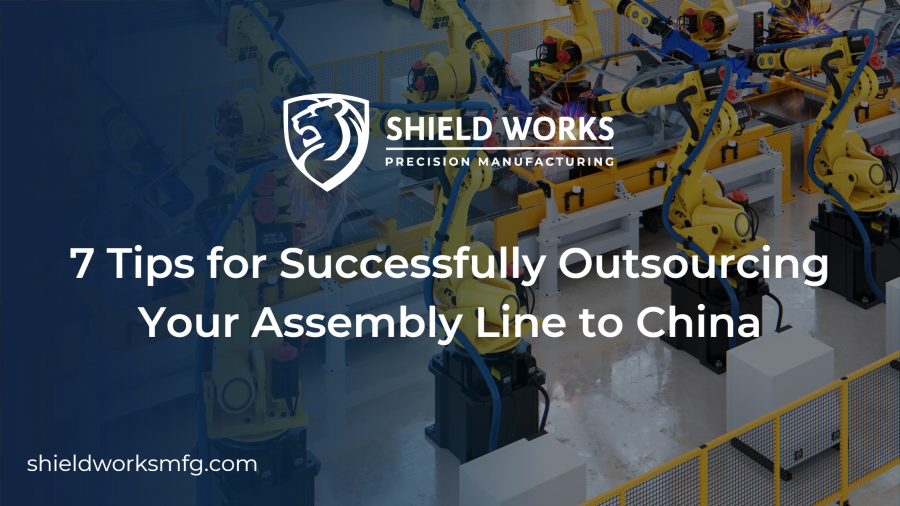7 Tips for Successfully Outsourcing Your Assembly Line to China

The next time you need to manufacture and sell your product, you might consider outsourcing the assembly work to China. While this solution will certainly save you time and money, it’s not without its challenges, so take some time to prepare yourself before going all-in on outsourcing your manufacturing and assembly line to China. Here are seven tips for outsourcing your assembly line successfully to China.
1) Know your facts
When outsourcing anything, it is important to cover all your bases beforehand. Product assembly, however, is unlike most business processes because. all revisions have to happen ahead of time, and things are more complex when outsourced to international firms in Asia.
To illustrate, for example, if a supplier misreads your email and ships 100 units instead of 10, it could cost you thousands of dollars and waste even more time. It is critical that you confirm every detail- from the length and width of each piece to the location of holes or slots -before you start your project.
In the event that any directions are confusing or feel like they’re missing information, please get in touch with your supplier.
2) Find a company that suffices
You need to consider where your products will be shipped from. If a made in China label is part of your business plan, you should know what your options are for assembly and shipping.
Is it important for you to discuss your upcoming lead time, incoterms, and final delivery details with multiple suppliers? Making a product in China is flexible. Your candidates can go to great lengths to win your business. You may have better options depending on the factors that matter most to you, such as price or quality.
And if one company fails to live up to their promises, there’s always another willing contender who might give you a better deal. In many cases, international trade is all about bargaining and negotiation.
A good way to start the process of finding a reliable overseas manufacturer is by looking at current job listings for manufacturing positions in Asia. Or search for manufacturers who already make your type of goods.
3) How you communicate
The most crucial step in product assembly outsourcing is effective communication with your supplier. Make a choice of communication style and stick to it be sure to find your favorite form of communication, and stick to it.
For example, if you prefer email, then make sure that your emails are punctual and detail oriented. In a phone call, talk less than the other party as often as possible, while in video conferences, start talking more often.
The WeChat application is well used in China. It might be the perfect solution for people who want quick replies. Regardless of what level of formality you think you should have with another person–stay with one style that is appropriate for the two of you.
4) Have a presence on-site for quality
In the case of new or complex products, you should definitely have someone on-site checking quality control. In the case of well-established and simple products, some entrepreneurs may trust their suppliers much more and forgo regular quality control visits.
It will be nearly impossible to travel to China physically with current restrictions. Keeping in touch with your supplier can help prevent mistakes before they occur. Video-record yourself demonstrating how your product works so that you can send it over if questions arise during production (for tips on how to do these types of videos). With WeChat, you can use it anywhere in the world.
5) Price and quality can co-exist, with the right manufacturer
People often choose what they believe to be a lower-cost option due to time constraints. Poor quality or poor communication will often cause production delays and parts to get lost, resulting in much higher costs.
By finding reliable manufacturers who adhere to agreed-upon pricing structures, you’ll ensure that price won’t be a deal breaker.
If you find a manufacturer who does not compromise quality for low costs, your project will stay on schedule and under budget from launch to completion. Establishing clear ground rules with your manufacturers from the beginning can prevent problems that result in overruns later on.
6) Have A Timeline
Try setting a deadline for when you would like your product assembled and shipped. Since outsourcing overseas is difficult, as it may take long without knowing how long things will take, it may be stressful to be juggling different deadlines.
Setting a deadline will enable you to schedule and manage your time better, because many companies that work with foreign manufacturers are also able to help you with logistics and delivery, so you’ll be able to deliver your product on time.
7) Quality Control System All The Way
When you’re outsourcing product assembly to China, it’s important that every step of manufacturing undergoes quality control. Inspecting your products at each step guarantees that an oversight or mistake during one stage of production doesn’t cascade and lead to a shipment of defective products—which can result in expensive returns, dissatisfied customers, and even lawsuits.
It can help identify the root of problems, thus what additional quality control measures are needed to keep them from arising. Quality control is crucial for outsourced manufacturing since a short-sighted approach may miss an important step. For instance, some manufacturers may put too much glue on an item or use the wrong type of glue for it, both of which would render it unusable or break it very easily.
A manufacturer with great experience can help you go a long way, like Shield Works. We have 17 years of experience with industry-spanning expertise. If you have any questions regarding our contract assembly service, please do not hesitate to contact Shield Works.
